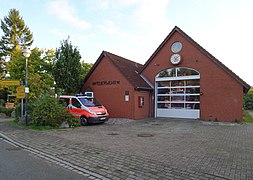Döhnsdorf
Coordinates: 54 ° 17 ′ 40 ″ N , 10 ° 43 ′ 55 ″ E
Döhnsdorf ( Low German Döhnsdorp ) is a village near the B 202 in the municipality of Wangels in the Ostholstein district in Schleswig-Holstein .
history
Döhnsdorf was probably founded around 1200. However, there are no written sources. Döhnsdorf may have been settled by a locator whose name ( Dbod- des Dönies ) can be derived from “Antonius”. The place is first mentioned in 1329 as Elerus de Donestorpe and in 1330 as Luderus de Donestorpe and in 1340 in villis ... Donestorpe . There are several theories about the naming, one of which establishes the connection to dunes , another suggests that new settlers brought the place name with them from their old homeland.
In the early Middle Ages , the knight deployed in Döhnsdorf had a defensive tower built to protect the farmers. The complex is known today as Döhnsdorf Castle . Around 1440 Döhnsdorf belonged to the knight Gottschalk von Ahlefeldt . In 1607 Döhndorf became part of the newly established Weissenhaus estate and remained in its possession until 1928. After that, the properties in Döhnsdorf belonging to Gut Weißenhaus were sold to Höfebank in Kiel for settlement purposes. Only then could the farmers become owners of their farms.
Historical development
After the village was sold to the Höfebank in 1930, the following jobs were created: five hooves , one pitcher , four katen and 14 inns .
There are several culturally and historically interesting buildings along the village street.
- Farmhouse "Nogelkassen", an Instenstelle from the 18th century, year of construction unknown.
- Craftsman's house, built in 1793, is the oldest original house in Döhnsdorf.
- Hooves from the 18th century, year of construction unknown, still owned by the family today.
- The old school, built in 1830, was closed for teaching purposes in 1968 and sold in 1971.
Döhnsdorf in recent times
In 1830 the Döhnsdorf school was opened. It existed until 1968 and the remaining students came to the Hansühn Village Community School . The old school building is used privately today. On January 17, 1907, the Döhnsdorf-Wasbuck volunteer fire brigade was founded at the request of the manor. After 1928 Döhnsdorf, Weißenhaus, Friederikenhof and Wasbuck formed the rural community of Weißenhaus. Towards the end of the Second World War , residents from Kiel and Hamburg were quartered in the village, so the number of students rose to 90 by the end of April 1945.
In 1993 a village renewal was completed at a cost of 4.8 million DM. It included, among other things, a central local drainage system, the expansion of the Dorfstrasse and the expansion of the sewer network. Some of the culturally and historically interesting buildings along the Dorfstrasse were provided with information boards.
population
According to a census of 1803, the population was 197 people, spread over 45 families. By 1860 the population grew to 279 people, spread over 57 families and 27 buildings. Today (2018) 215 people live in Döhnsdorf, which thus has the third largest population density within the municipality of Wangels.
photos
supporting documents
- Döhnsdorfet home and history association: The name Döhnsdorf
- Döhnsdorfet Heimats- und Geschichtsverein: History of the village of Döhnsdorf
- Information boards in Döhnsdorf, designed by the Döhnsdorfet Heimats- und Geschichtsverein








